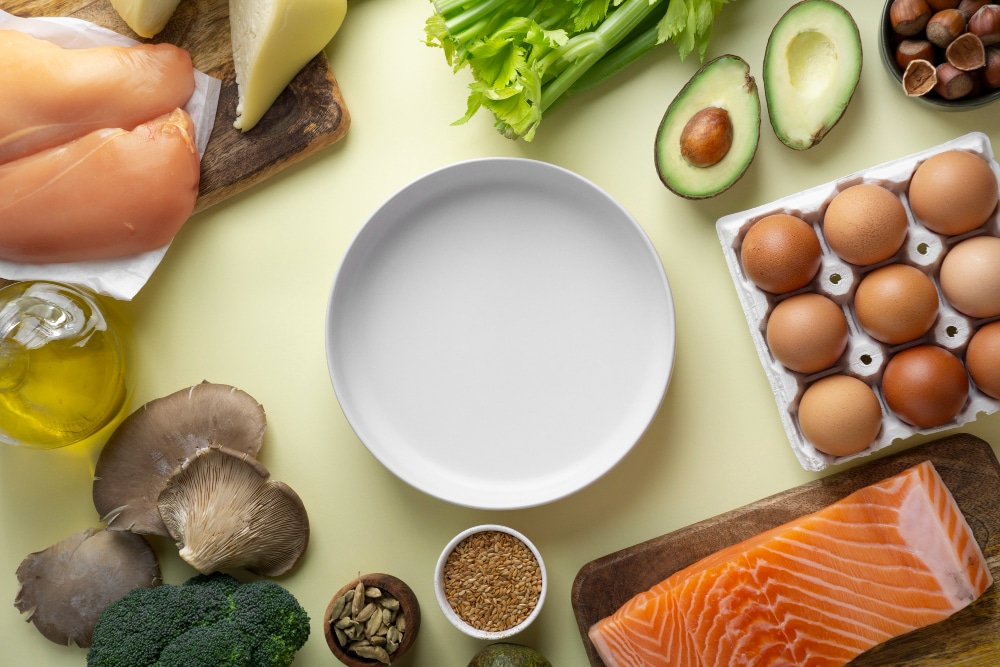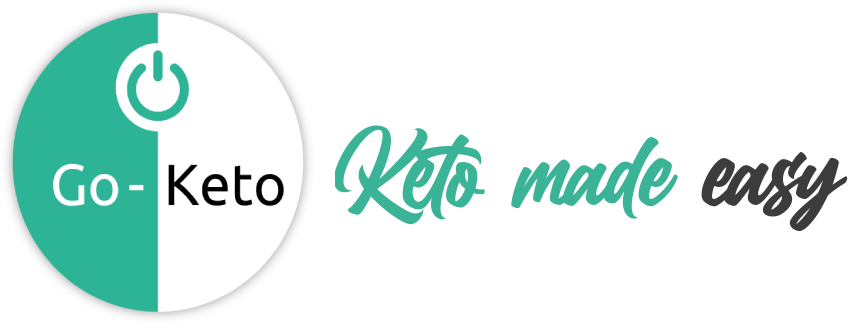Are you looking to start with the ketogenic diet? Before we get started, let’s calculate the weighting of your macronutrients. Unlike more traditional diets, the macronutrient split for the ketogenic diet favours a higher fat contribution, with a moderate protein allowance, and low to zero carbohydrates.
With the information you enter into the calculator, we can create an accurate macronutrient profile to help you get into ketosis and achieve your goals.
Information
Ageyears
WeightKg
Heightmeters (e.g. 1.76 meters = 176 cm)
Weightlbs
Heightfeet inches
Weightstones lbs
Heightfeet inches
Body fat%
Net carbsgrams
Specify the amount of daily net carbs you’d like to consume. Typically, 20-30 grams is recommended to start with.
Results
Maintenance
Maintenance level is the level at which your weight remains stable.
| Your BMR is: | 1536 | kcal |
| Calories to consume: | 2027 | kcal |
| Your fat intake should be: | 184 | grams |
| Net Carbs | Protein | Fat | |||
| 25 | grams | 69 | grams | 184 | grams |
| 100 | kcal | 275 | kcal | 1653 | kcal |
| 5 | % | 14 | % | 81 | % |
Goal
Sorry, cannot offer any weight loss suggestions. Please use the Custom section for weight loss macro targets.
Your body fat is too low. You should have a minimum of 3% body fat (essential fat you cannot lose). It is not advisable for you to lose any more weight.
Based on the amount of net carbs you specified, it would impossible to lose any weight. Please, reduce the amount of net carbs and try again.
Below is a range of calorie deficits to help you lose weight. For best results, it is recommended that you opt for a moderate calorie deficit of 10-20%.
Small calorie deficit (11%)
| Calories to consume: | 1804 | kcal |
| Your fat intake should be: | 159 | grams |
| Net Carbs | Protein | Fat | |||
| 25 | grams | 69 | grams | 159 | grams |
| 100 | kcal | 275 | kcal | 1430 | kcal |
| 6 | % | 15 | % | 79 | % |
Moderate calorie deficit (22%)
| Calories to consume: | 1581 | kcal |
| Your fat intake should be: | 134 | grams |
| Net Carbs | Protein | Fat | |||
| 25 | grams | 69 | grams | 134 | grams |
| 100 | kcal | 275 | kcal | 1207 | kcal |
| 6 | % | 17 | % | 77 | % |
Large calorie deficit (33%)
| Calories to consume: | 1358 | kcal |
| Your fat intake should be: | 109 | grams |
| Net Carbs | Protein | Fat | |||
| 25 | grams | 69 | grams | 109 | grams |
| 100 | kcal | 275 | kcal | 984 | kcal |
| 7 | % | 20 | % | 73 | % |
Below is a range of calorie surpluses to help you bulk up and gain muscle size. Keep in mind that you will need to add physical activity (weight training) in order to increase your muscle mass. For best results, it is recommended that you opt for a moderate calorie surplus of 10-20%.
Calorie surplus (10%)
| Calories to consume: | 2231 | kcal |
| Your fat intake should be: | 206 | grams |
| Net Carbs | Protein | Fat | |||
| 25 | grams | 69 | grams | 206 | grams |
| 100 | kcal | 275 | kcal | 1856 | kcal |
| 4 | % | 12 | % | 84 | % |
Calorie surplus (15%)
| Calories to consume: | 2332 | kcal |
| Your fat intake should be: | 218 | grams |
| Net Carbs | Protein | Fat | |||
| 25 | grams | 69 | grams | 218 | grams |
| 100 | kcal | 275 | kcal | 1958 | kcal |
| 4 | % | 12 | % | 84 | % |
Calorie surplus (20%)
| Calories to consume: | 2434 | kcal |
| Your fat intake should be: | 229 | grams |
| Net Carbs | Protein | Fat | |||
| 25 | grams | 69 | grams | 229 | grams |
| 100 | kcal | 275 | kcal | 2059 | kcal |
| 4 | % | 11 | % | 85 | % |
Enter the calorie intake adjustment. For a calorie deficit (weight loss) enter a negative value (e.g. -10) while for a calorie surplus (weight gain) enter a positive value (e.g. 15). It is recommended that you opt for a moderate calorie deficit or surplus.
Calorie adjustment:%
Custom adjustment (0%)
| Your BMR is: | 1536 | kcal |
| Calories to consume: | 2028 | kcal |
| Your fat intake should be: | 184 | grams |
| Net Carbs | Protein | kcal | |||
| 25 | grams | 69 | grams | 184 | grams |
| 100 | kcal | 275 | kcal | 1653 | kcal |
| 5 | % | 14 | % | 81 | % |
Your next steps to kickstart the keto journey
If you are wondering how to start your keto journey, or to keep you in ketosis without being distracted, you can try our keto snacks products. The Go-Keto Granola and Bread-Mix are perfect for starters, and we have those trial packs with a sweet discount option.
How do you calculate your fat percentage?
Our keto calculator requires your body fat percentage to calculate your lean body mass. With this percentage we can calculate just how much protein you need in order to achieve your goal. Eating too little or too much protein on a keto diet (or any type of diet for that matter) can lead to dangerous or unwanted results. You can calculate your body fat percentage using specialised home bodyweight-scales, or for more accurate results, through the use of a DEXA scan. These are however only available at certain gyms or through your local physician. If you don’t have access to either of these options, you can always use a skinfold test with callipers.
How many carbohydrates would you like to consume per day?

It is strongly recommended that you limit carbohydrate intake to 5% or less of your total daily calories on a keto diet. This equates to an average of 20 grams of net carbohydrates per day.
With a keto diet, the general rule of thumb is to stay below 30 grams of net carbohydrates per day. If your goal is to lose weight, we recommend staying at, or below 20 grams of net carbohydrates per day, as the end goal of a ketogenic diet is to get into ketosis, the metabolic state of burning fat.
The number of carbohydrates you can eat depends on your goals and your calorific intake, but it also varies per person as to how quickly you get into ketosis. If at some point it turns out that you get into ketosis very quickly and lose weight rapidly at only 20 grams of carbohydrates, you can increase this value slightly.
From the results of the keto calculator, in conjunction with the keto-strips, you can keep track of whether your body is in ketosis or not.
What is the macronutrient ratio ketogenic diet?
By simply eating fewer carbs and choosing high-fat content foods, most people will eat fewer overall calories and subsequently lose weight. But by eating this way however, you might reach a plateau in your weight loss.
A solution to this is by tracking your macronutrient values using a macronutrient tracker, as it gives you a guideline for how much you should consume. The results give you an estimate for fat, protein, carbohydrates, as well as the calories you can consume each day.
Everyone is different, so the recommended macronutrient intake within a keto diet will also be different. The breakdown depends on how active you are, whether you undertake sports and, of course, your personal goal.
In general however, the macronutrient breakdown for the ketogenic diet is: 70-75% fats, 20-25% proteins and 5% carbohydrates.
How do you count your macros?
Counting macros is easy with the help of various apps. The most popular on the App stores are MyFitnessPal or Cronometer, each complete with extensive databases for foods and the ability to add it in for yourself. All you need to do is adjust the calorific amount to what you are eating and then the App automatically calculates everything for you. Each macronutrient has its own energy value, which is useful to know if you want to manually count your macros yourself.
- 1 gram of fat = 9 kcal
- 1 gram of protein = 4 kcal
- 1 gram of carbohydrates = 4 kcal
You will see that fats quickly add up to your calorie intake, meaning you won’t get the strong hunger pains during weight loss, keeping you sated for longer.
From using our keto calculator, you’ll find out how much of each macronutrient you need to consume. You can:
- Significantly increases your chances of achieving the desired results
- Enter and stay in ketosis
- Learn about how much you need to eat
- Enjoy all the benefits of being in ketosis
- Better manage your eating patterns
Where to find high quality macros?

It doesn’t have to be difficult to get the necessary macros. Ban non-keto foods from your diet and go keto-friendly. Here’s a short list of ground rules to get you started:
Stay away from:
- Grains – wheat, maise, rice, grain, etc
- Sugar – honey, agave, maple syrup, etc
- Fruits – apples, bananas, oranges, etc
- Starch – potato, yams, etc
Eat more of:
- Meat – fish, beef, lamb, poultry, eggs, etc
- Low-carb vegetables – broccoli, cauliflower, spinach, kale and others
- Fatty dairy – hard cheeses, high fat cream, butter, etc
- Nuts and seeds – macadamias, walnuts, sunflower seeds, etc
- Avocado and berries – raspberries, blackberries and other low glycaemic index berries
- Sweeteners – stevia, erythritol, monk fruit and other low-carb sweeteners
- Other fats – MCT coconut oil, high-fat salad dressing, saturated fats, etc
Setting your goals to get results
When you enter how active you are, this gives us an idea as to the minimum amount of calories your body with burn every day. Our keto calculator uses this minimum value to calculate your Basal Metabolic Rate (BMR), the number of calories you burn whilst your body is at rest, or digesting food. In addition to your BMR, your body fat percentage is used to estimate how many calories you need to reach your goals. Your energy expenditure is divided into four categories:
- Inactive: sedentary work with little to no exercise
- Slightly active: job with light movement and 1-3 light exercise sessions a week
- Moderately active: active work and 3-5 exercise activities a week
- Very active: heavy physical work and more than 5 exercise activities a week

Together, these figures form the Total Daily Energy Expenditure (TDEE), the estimate of your total calories burnt per day. If you use a heart rate monitor or third-party software to track your calories, you can use the custom input in the activity level section for an even more accurate macronutrient profile. For example, you can enter that you have run for an hour where you have burned X kcal.
Whether you want to lose weight, maintain, or gain weight with the keto diet, our calculator can determine how much you should eat. Be sure to select surplus or deficit in the calculator.
What is a surplus / deficit?
A surplus or deficit refers to the number of calories above or below your TDEE. When you want to gain weight (usually for muscle gain), your body needs to have more calories at is disposal. Whereas if losing weight is your goal, your body needs to have a restricted amount of calories to work with.
If your goal is to lose weight, you need to be in a calorie deficit and the standard range is 10-20%, this is because it’s sustainable over a longer period of time. 20-30% is manageable for a faster timeframe, but may be less sustainable in the long run. Going greater than 30% is not recommended as it may lead to metabolic damage.
If you want to gain more muscle mass, you need to be consuming a surplus of calories. Typically a 5-10% increase in calories is recommended for sustainable muscle gains.
How much protein should I eat?
Proper protein management is imperative on the keto diet. If you consume too much protein, you will kick your metabolism out of ketosis, and with too little protein you risk losing muscle mass. Finding the right balance is key. Based off your physical activity level, the following is recommended[1]:
- At a low activity level, it is recommended to eat between 1.2-1.8 g/kg (0.54-0.82 g/lb) for protein in grams per your bodyweight.
- If you are active, it is recommended to eat between 1.4-2.0 g/kg (0.64-0.91 g/lb) for protein in grams per your bodyweight.
- If you want to build muscle, it is recommended to eat between 1.6-2.4 g/kg (0.73-1.10 g/lb) protein in grams per your bodyweight.
This is the ratio of protein to lean body mass. It is calculated when you take your bodyweight and subtract the percentage of your bodyfat. The keto calculator automatically sets your protein based on your activity level.
The easiest way to meet your protein goals is to ensure you consume a good source of protein with every meal. Here are some of the most common protein sources to add to your keto meals:
- Fish
- Red meat
- Eggs
- Shellfish
- Poultry
- Pork (Bacon and sausage)
- Nuts
- Butter
- Cheeses with a lot of protein
- Low-carb protein powders
[1] Examine (2021) – Optimal Protein Intake Guide




